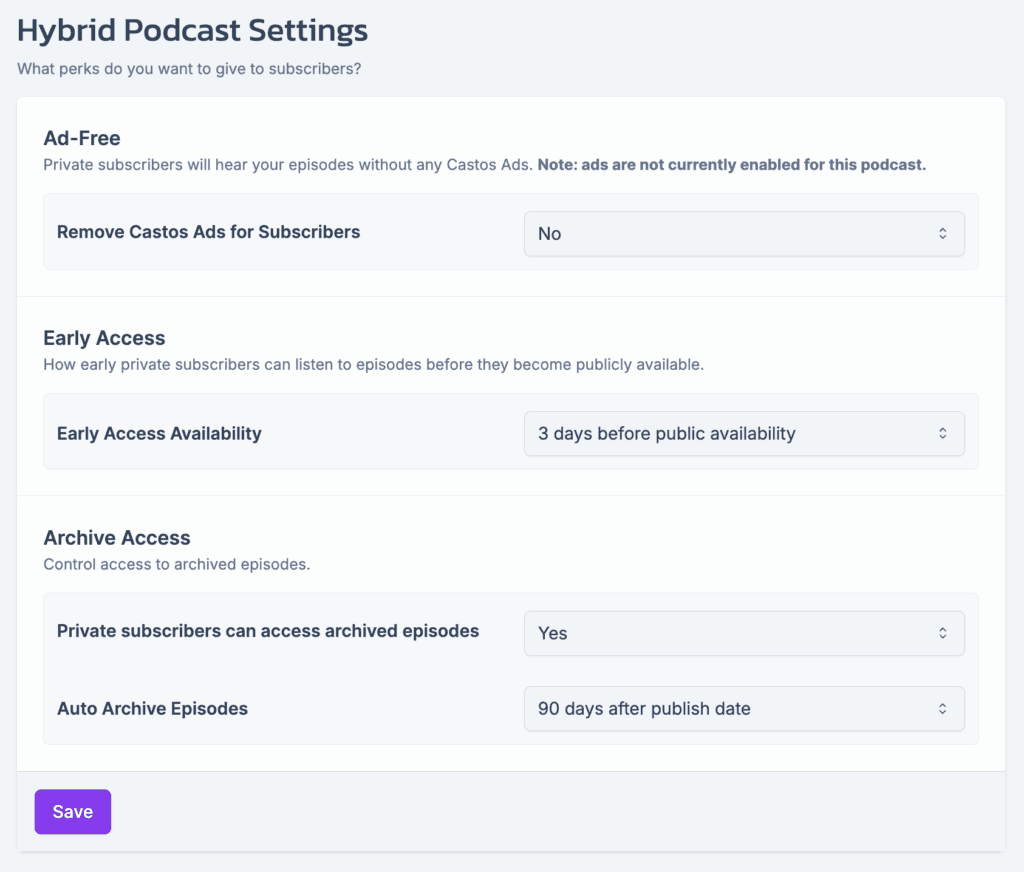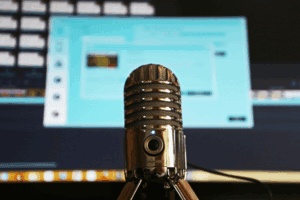Hybrid Podcasting sits in that sweet spot between public and private content, offering a “freemium” model similar to what you see with platforms like Substack.
You provide your regular public content while offering exclusive Subscriber Benefits to your most engaged fans, creating deeper, more profitable connections with your audience.

We look at Hybrid Podcasting as just a tool you can use to suit your podcast, your brand, and your audience needs best. But since this is such a new concept in podcasting, we’ve put together 10 ways to make hybrid podcasting work for your brand.
1. Email Marketing Integration
One of the most exciting aspects of hybrid podcasting is how easily it integrates with your existing email marketing workflow.
Castos already offers native integration with Kit (formerly ConvertKit), allowing you to automatically add subscribers to private or hybrid podcasts based on specific tags and custom events in your email list.
Here’s how it works:
- You mention in your podcast episode that listeners can get ad-free episodes, access to your back catalog, or early access to new content by joining your email list.
- Listeners join your email list from any landing page or form on your site
- Within Kit, you simply tag them or use a custom field in Kit, which automatically syncs with Castos through the native integration.
- The subscriber immediately gets access to those premium benefits and an enhanced version of your podcast.
This automation removes friction from the subscriber experience while ensuring your most engaged listeners get rewarded for their loyalty.
By the way, Kit is the only email platform we currently have a direct integration with, but you can replicate exactly the same kind of “When X happens, do Y in Castos” with Castos’ Zapier integration. Think: membership platforms, course software, marketing automation, payment gateways, etc.
2. Create Personalized Experiences for Customers
Imagine having a public podcast that generates awareness and brand recognition, while at the same time offering exclusive perks for your existing customers.
This approach works great for agencies and productized services.
Take financial advisors, accountants, tax strategists, or wealth managers, for example. You could incentivize prospects to become customers (or reward existing customers) by providing access to individualized private episodes available only to hybrid subscribers.
The key difference here is that hybrid podcasts mix public and private content, while private podcasts contain only private episodes. This flexibility allows you to serve both audience acquisition and customer retention goals at the same time.
Your existing clients get additional value through exclusive content, while prospects see the premium experience they’ll receive when they become customers.
Win, Win, Win.
3. Directly Monetize Exclusive Content
Thanks to Castos’ integration with Stripe, you can directly sell premium podcast content with almost zero setup.
Here’s the process:
- You promote your free podcast as usual
- In the podcast (or on your Podcast Website) offer a link to the premium version featuring extra behind-the-scenes episodes, extended interviews, or bonus content for paying subscribers.
When someone signs up through your Stripe checkout, the payment automatically triggers their addition as a private subscriber in Castos, giving them immediate access to premium content.
For Apple users, Castos also integrates with Apple Podcast Subscriptions, providing this same functionality directly within the Apple Podcasts mobile app.
This dual approach ensures you can monetize across different platforms and payment preferences.
4. Internal Corporate Communications
Many larger organizations are discovering the power of podcasting for internal communications. Not necessarily as an outward-facing marketing tool, but as a way to communicate with employees within the company.
While most corporate podcasting happens in strictly private settings, hybrid podcasting opens new possibilities. You could create content where certain episodes go to all employees, while specific content reaches only certain business groups, locations, or leadership levels.
We’ve seen amazing results from Internal Company Podcasts in how they transform traditional corporate communications, making internal updates more engaging and accessible than typical email broadcasts or intranet posts.
5. Repurpose Exclusive Content for Lead Generation
Here’s where hybrid podcasting gets really spicy.
Instead of focusing primarily on paid subscriptions, for some brands the biggest opportunity lies in list building and lead generation.
Consider repurposing valuable content you’ve already created. These are assets like like paid webinars, conference presentations, or exclusive training sessions, and package them as bonus content for hybrid podcast subscribers.
An audience member to your public podcast could get this premium content in exchange for their email address, making it a win-win scenario.
This strategy works because you’re offering genuinely valuable content (that required real effort to create) without additional work on your part.
Whether it’s a private training session, conference keynote, or special episode, you’re exchanging real value for email addresses and deeper audience engagement.
6. Connect with Online Communities
Since launching Hybrid Podcasting, we’ve seen creators take Q&A sessions from platforms like Skool, Circle, or Mighty Networks and offer them as lead magnets to people evaluating community membership.
This strategy adds value outside your regular marketing podcast for people who could become your best future customers. It’s particularly effective for community builders who want to showcase the type of exclusive content and interaction community members receive.
The approach demonstrates community value while capturing leads from people genuinely interested in your premium offerings.
7. Enhance Paid Advertising Campaigns
This strategy is still emerging, but it’s incredibly promising: using private podcasts as the fulfillment mechanism for paid advertising campaigns.
Hear me out.
Instead of traditional lead magnets like PDFs or long-form videos, you could run Meta or YouTube ads offering exclusive podcast content. When someone enters their email, they’re added to your marketing automation system and receive access to your private or hybrid podcast.
From a user experience perspective, this could be really compelling.
Many people prefer consuming audio content while walking, commuting, or multitasking rather than sitting down to read lengthy PDFs or watch videos they’ll never finish.
If your audience prefers audio consumption and you want to build longer-term relationships, pairing private podcasting with paid acquisition could be a game-changer.
Meet your audience where they are, and match the message with the medium.
8. Reward Your Existing Audience
While much focus goes to acquiring new audience members, Hybrid Podcasting really wins with retention…maximizing the experience and lifetime value of existing subscribers, customers, or community members.
Instead of constantly chasing new people, why not add more value for those already in your world?
This could mean offering exclusive content to current newsletter subscribers, existing customers, or community members as a way to increase retention and demonstrate ongoing value.
This retention-focused approach often delivers better ROI than pure acquisition strategies, as engaged existing audience members are more likely to become customers and advocates for your brand.
9. Premium Content for Members
Building on the retention theme, consider how Hybrid Podcasting can enhance existing membership or subscription offerings.
If you already have a paid community, course, or service, exclusive podcast content can significantly increase the perceived value of membership.
This approach transforms podcasting from a marketing expense into a value-added service that justifies higher pricing or reduces churn in existing offerings.
10. Companion Content for Written Assets
With AI-generated content flooding the internet, authentic, human-created content stands out more than ever.
Many creators naturally prefer writing as their primary medium, then typically distill content down through various formats.
Hybrid Podcasting flips this approach: start with your newsletter or blog post, then record an audio version of that content.
The twist is that this audio version isn’t available to everyone – people need to subscribe with their email to access it through your hybrid podcast.
This strategy works particularly well for writers who want to:
- Repurpose existing content without additional research
- Reach audience members who prefer audio consumption
- Build their email list using content they’re already creating
- Provide additional value to subscribers without doubling their workload
The Bigger Picture On Hybrid Podcasting
We’re biased, but we think that Hybrid Podcasting represents the most exciting technological development in podcasting in years.
It bridges the gap between broad audience building and direct relationship building, allowing you to serve multiple business objectives with a single content strategy.
The key is understanding that the biggest opportunity isn’t necessarily in paid subscriptions (though those can work). Instead, it’s in using the hybrid model to:
- Build deeper relationships with your most engaged audience members
- Grow your email list with high-intent subscribers
- Increase customer lifetime value through additional touchpoints
- Differentiate your brand in an increasingly crowded content landscape
Whether you’re a solopreneur, service provider, or larger organization, Hybrid Podcasting offers flexible options to enhance your existing content strategy without requiring completely new workflows or massive additional effort.
Getting Started with Hybrid Podcasting
Ready to transform your podcast from a passive audience-building tool into an active business growth engine? The strategies outlined above work best when you already have some audience momentum, but they can be implemented at any stage of your podcasting journey.
The key is starting with one approach that aligns with your current business model and audience preferences, then expanding from there as you see results.
Hybrid podcasting isn’t just about the technology – it’s about reimagining how podcast content can serve your broader business objectives while providing genuine additional value to your most engaged listeners.




